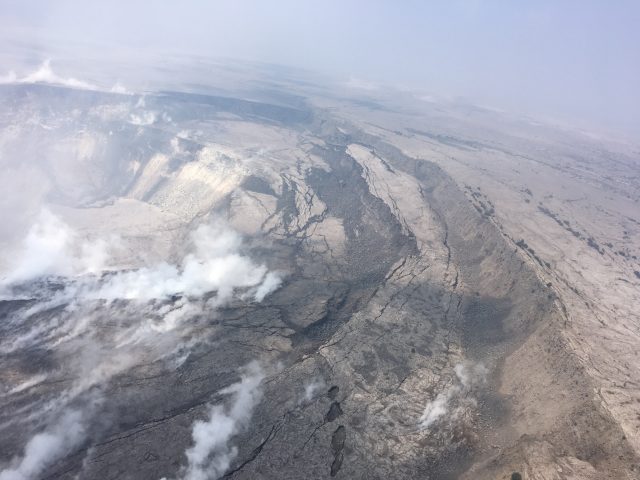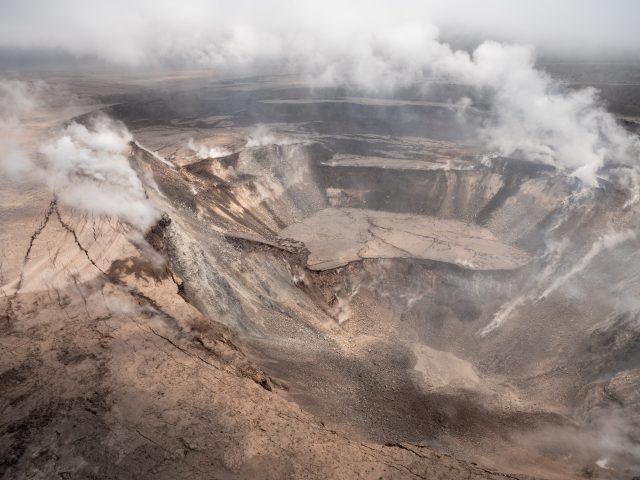15 June 2018
Kilauea volcano: large-scale slumping on the rim of Halema‘uma‘u crater
Posted by Dave Petley
Kilauea volcano: large-scale slumping on the rim of Halema‘uma‘u crater
The ongoing major eruptive event at Kilauea volcano in Hawaii has generated a wide range of spectacular videos and extensive news coverage. At the summit of Kilauea is the large Halema‘uma‘u crater, which has been undergoing major morphological changes in response to recent events. Most importantly, a little more than a month ago the lava lake that had occupied this space drained down. In response, the walls of the crater have undergone large-scale slumping. Volcanic landslides are well-documented, but rarely in this level of detail.
The USGS has a page that provides their latest photographs and videos of the Kilauea eruptive event, which includes remarkable imagery of these slumps. For example, this image shows the sequential curved tension cracks that mark the back of a series of large slumped blocks:-

Cracking and slumping of the Halema‘uma‘u crater walls are clearly evident in this aerial view captured during HVO’s overflight of Kīlauea’s summit on 9th June 2018. Image from the USGS.
.
Whilst the image below gives a wider perspective view of this slumping process. In some cases the slumped blocks have deformed by over 100 metres:-

Slumped blocks at the Halema‘uma‘u crater. Image via the USGS, collected on 12th June 2018.
.
There is a wonderful drone video, collected this week, that provides a panoramic overview of the deformation.
This is a textbook case of slumping in response to changes in the local stress state. We see successive slump blocks like this in conventional landslides too, though rarely with such clarity. A very interesting element of this is the lack of rotation in the blocks, none of which appear to be backtilted. I wonder if this is because of the circular planform of the blocks (whereas in non-volcanic landslides they tend to have a more linear planform). Presumably this circular shape inhibits the development of rotation.
The USGS have been monitoring the development of these slumps at Kilauea, so in due course there should be some fantastic data on the ways in which these landslides evolve.


 Dave Petley is the Vice-Chancellor of the University of Hull in the United Kingdom. His blog provides commentary and analysis of landslide events occurring worldwide, including the landslides themselves, latest research, and conferences and meetings.
Dave Petley is the Vice-Chancellor of the University of Hull in the United Kingdom. His blog provides commentary and analysis of landslide events occurring worldwide, including the landslides themselves, latest research, and conferences and meetings.
Hi Dave,
Thanks as always for pointing this out.
What about potential impact from the many earthquakes in combination with the draw down, its a pretty dynamic place up there. The rim would probably result in signification amplification. As usual many suspects and a few missing data clues, not including the changes in the rim walls with any solidified lava, spatter, etc.. Non the less great images and examples of slope deformations in this environment. I hope they are looking at the multi-hazard impacts associated with rim instability.
Regards,
Edward
Teddy, is that you, teaching in some faraway land? I like the consideration of interactivity of seismic and sliding compounding the effect of the emptying magma chamber. Doesn’t the lack of backrotation have something to do with the availability of space below (i.e., the magma chamber), “kinematically” allowing dropping of an entire block, as opposed to rotation being required to daylight at a slope toe?
The lack of back rotation on the blocks is probably due to difference in the process. Generic slump-type landslides have lateral movement at the toe, creating a roughly circular failure surface. In the case of this volcano, the magma chamber is draining, removing material and support from below. Since the bottom of the sliding surface is downward instead of lateral (as in the slump-type landslide situation) the failure surfaces within the volcano are essentially conical.
Great photos but I agree with Michael Zimmerman that they show subsidence not slumping. Subsidence is not usually included in landslide classifications though Sharpe’s Landslides & Related Phenomena (1938) makes a case. His Figure 13 shows a cartoon of typical movements.
Striking similar to the supervolcano found in Arabia, Mars.